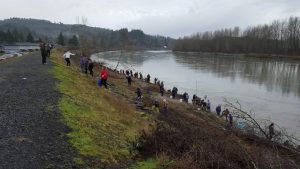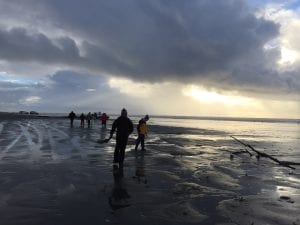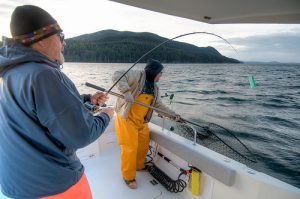Chances of smelt dip-net fishery on Cowlitz River are unlikely, but hinge on in-season updates Leave a reply

Dip-netters in 2016 look for smelt along the Cowlitz River banks. Photo courtesy of Olaf Langness with state Fish and Wildlife.
The possibility of having a smelt season on any tributary of the Columbia River – including the highly popular Cowlitz River dip-net fishery – is still up in the air, but chances are very slim according to the latest news coming out from the Washington Department of Fish and Wildlife (WDFW).
They’re predicting the smelt return to the Columbia River in 2018 return could be smaller in magnitude than the 1.6-million that returned in 2017.
Smelt abundance increased steadily from 2011 to 2014, reaching a peak of 16.6-million pounds in 2014 and has since declined the past three years.
Ocean environmental conditions were favorable for marine survival during 2012-2013, but have deteriorated the past three years.
Both commercial and recreational fisheries were closed to all harvest in 2011-2013.
The sport dip-net smelt fishery used to be very popular from the 1980s to the early 2000s before they started to steadily decline to the point where they were added to the Endangered Species Act listing in the spring of 2010.
Since then fisheries have either been closed or limited just like last year’s brief one-day fishery on Feb. 25 that produced a meager 540 pounds along the banks of the Cowlitz River in southwest Washington compared to 141,050 pounds during a sport dip-net fishery on Feb. 6 in 2016.
That 2016 return was apparently a good run – 5.1-million pounds based on spawning stock biomass – but less than 2015’s return of 11,400,00 pounds.
There were also fishing seasons– five days total in 2014 and two days in 2015 – along with smelt dip-netting opportunities in the Sandy River on the Oregon side of the Columbia River.
The 2014, 2015, 2016, and 2017 commercial fisheries each consisted of eight fishing periods over four weeks on the Columbia River mainstem.
Here is a rundown of past Columbia River total run sizes and harvest catches:
2017: 1,600,000 pounds with 5,090 pounds caught in non-tribal commercial fishery, 540 pounds in sport fishery and 1,900 pounds in the tribal fishery.
2016: 5,100,00 pounds with 4,820 pounds caught in non-tribal commercial fishery, 141,050 pounds in sport fishery and 8,330 pounds in the tribal fishery.
2015: 11,400,000 pounds with 16,550 pounds caught in non-tribal commercial fishery, 290,770 pounds in sport fishery and 10,400 pounds in the tribal fishery.
2014: 16,600,00 pounds with 18,560 pounds caught in non-tribal commercial fishery, 203,880 pounds in sport fishery and 6,970 pounds in the tribal fishery.
2013: 9,600,000 pounds with none caught in non-tribal commercial fishery, none in sport fishery and 7,470 pounds in the tribal fishery.
2012: 3,200,00 pounds with none caught in non-tribal commercial fishery, none in sport fishery and no data available in the tribal fishery.
2011: 3,300,00 pounds with none caught in non-tribal commercial fishery, none in sport fishery and no data available in the tribal fishery.
Word on razor clams
It’s almost time to dig into coastal beaches!
The next round of razor clams digs are set to begin this Sunday (Jan. 28), and this dig period will continue for an extended period of time.
Digging is open during P.M. low tides this Sunday, Jan. 28 (low tide is minus-0.4 feet at 4:06 p.m.) at Mocrocks; Monday, Jan. 29 (-1.0 at 4:59 p.m.) at Copalis; Tuesday, Jan. 30 (-1.5 at 5:47 p.m.) at Twin Harbors and Mocrocks; Jan. 31 (-1.6 at 6:33 p.m.) at Long Beach, Twin Harbors and Copalis; Feb. 1 (-1.5 at 7:17 p.m.) at Long Beach, Twin Harbors and Mocrocks; Feb. 2 (-1.0 at 8 p.m.) at Long Beach, Twin Harbors and Copalis; Feb. 3 (-0.4 at 8:42 p.m.) at Long Beach, Twin Harbors and Mocrocks.
According to Dan Ayres, the head WDFW coastal shellfish manager, turnout during the last digs on Dec. 31 at Long Beach, Twin Harbors, Copalis and Mocrocks had 24,817 diggers with 306,116 clams; and Jan. 1 at Twin Harbors and Mocrocks had 8,206 with 114,420.
“It was great news and they all did so well, but the bad news is they took more clams than we had anticipated,” Ayres said. “What that means is we may have to shorten what we do down the road.”
The average at Long Beach was 10.2 clams per person (10,048 diggers Dec. 31 took home 102,176 clams); at Twin Harbors it was 13.3 (9,299 Dec. 31-Jan. 1 with 123,521); at Copalis it was 14.0 (5,639 Dec. 31 with 78,693); and at Mocrocks it was 14.5 (8,037 Dec. 31-Jan. 1 with 115,146). The daily limit is the first 15 razor clams dug regardless of size or condition.
The season total for 12 days of digging that began Oct. 6 is 87,379 diggers with 1,001,074 razor clams. Season average per digger is 10.8 at Long Beach (47,071 diggers with 507,450 clams); 12.4 at Twin Harbors (26,842 with 332,397); 12.6 at Copalis (24,791 with 311,833); and 12.9 at Mocrocks (21,698 with 280,271).
Once WDFW gets assessments of the these digs they will look at more options heading into the months ahead.
Chinook action remains above average in San Juan Islands
The hatchery chinook fishery remains good in the San Juan Islands with plenty of larger-sized fish.
The San Juan Islands (Marine Catch Area 7) is open through April 30 for hatchery chinook.
Anglers were still finding a decent number of larger-size hatchery chinook, 8 to 15 pounds, off Spring Pass, Thatcher Pass; Parker Reef and Point Thompson off the north side of Orcas Island; Peavine Pass and Obstruction Pass off Obstruction Island; Tide Point on Cypress Island; Waldron Island; Lopez Pass; and Presidents Channel.
On Jan. 18-20, 357 anglers in 100 boats caught 179 hatchery chinook in the Roche Harbor Salmon Classic. Robert Enselman of Stanwood took first place with a 17 pound-11 ounce chinook; second was Larry Surdyk of Snohomish with a 15-15; third was Dustin Walker of Oak Harbor with a 14-10; and tied in fourth place were Vicki Klein of Friday Harbor and Michael Beard of Oak Harbor with 13-11.
The derby is part of the NMTA’s Northwest Salmon Derby Series, which is has 15 events in 2018.
Next up is the Friday Harbor Salmon Classic on Feb. 8-10. Derby details: http://www.nwsalmonderbyseries.com/derbies/.
Many are also eagerly awaiting the Feb. 16 opener of northern Puget Sound (Area 9), and possibly the east side of Whidbey Island (Areas 8-1 and 8-2).
Both 8-1, 8-2 and 9 had closed sooner than expected back in November due to lots of under-sized chinook – fish under the 22-inch minimum size limit – appearing in catches.
Test fishing still shows catches of sub-legal fish remains high. In Area 9 the average marked size is 20.07 inches and maximum size is 24.43 inches. In Area 8-1 it is 14.30 and 25.39, and in Area 8-2 it is 17.04 and 22.13.
The San Juan Islands (Area 7) has seen hatchery chinook averaging 22.55 inches with a maximum size of 27.56 inches.
In central Puget Sound (Area 10) state fisheries raised the daily catch limit for hatchery chinook from one to two daily until the fishing season ends on Feb. 28.
In Area 10 there is enough in the catch quota guideline to boost the daily limit. Test fisheries have shown the average marked chinook size is 18.23 inches with a maximum size of 26.63 inches.
Other marine areas still open through April 30 are south-central (Area 11), Hood Canal (Area 12) and southern Puget Sound (Area 13). The western Strait of Juan de Fuca (Area 5) opening from March 16 to April 30; and eastern Strait of Juan de Fuca (Area 6) opening from March 1 to April 15.



